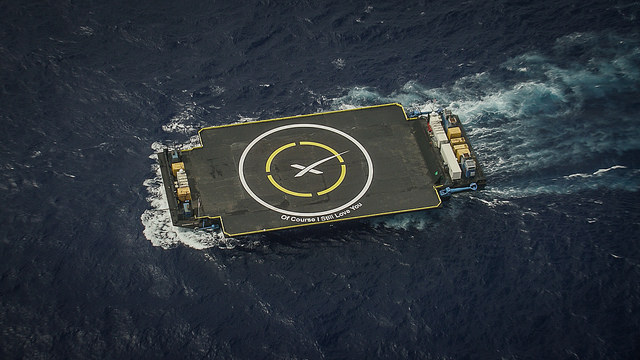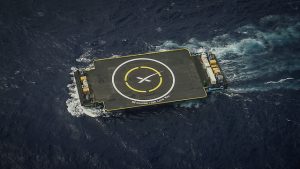News
What’s next for SpaceX’s Falcon 9 now that it can land on its own?
SpaceX has a busy month ahead of it! When Elon Musk tweeted that he was going to need a bigger rocket hangar, he wasn’t kidding. Three are already back home from their successful missions to orbit and back, and now there are four more Falcon 9 rockets ready to take to the skies before the end of June. Mission control, we are go for launch!

SpaceX has a busy month ahead of it! When Elon Musk tweeted that he was going to need a bigger rocket hangar, he wasn’t kidding. Three are already back home from their successful missions to orbit and back, and now there are four more Falcon 9 rockets ready to take to the skies before the end of June. Mission Control, we are go for launch!
But first, let’s relive those prior landings for just a moment, shall we?
May 6, 2016
April 8, 2016
December 21, 2015
Launch Details
Next up for SpaceX is the 25th Falcon 9 launch from Cape Canaveral, Florida scheduled for May 26th at 5:40 pm.
The payload for this launch will be the Thaicom 8 satellite, a commercial communications satellite built by Orbital ATK, and its mission is to provide Ku-band communications coverage for Thailand, India, and Africa. SpaceX previously launched another satellite in this series on January 6, 2014 called Thaicom 6. Want a little trivia on the Thaicom 6 mission? It was the final qualification launch that enabled SpaceX to be able to compete for U.S. Air Force launch contracts.
What is Ku-band?
Ku-band is a radio frequency used mostly for satellite communications, a certain section of which is designated for broadcasting services. To put things into perspective of other “bands”, it has the same purpose as the Ka-band (higher frequency) or C-band (lower frequency), but is more susceptible to weather conditions. For reference, DirecTV satellites use both Ka and Ku-band frequencies, their HDTV being broadcast almost entirely on the Ka-band.
If all goes well, this will be another Falcon 9 mission to Geostationary Transfer Orbit (GTO), just like the mission that launched and landed on May 6, 2016. GTO launches fly to 35,790 km above the Earth, pretty high in comparison to the maximum 528 km orbit of the space shuttle program. This means that when Falcon 9 returns, it will be coming in hot and fast again, needing a lot of counter thrust to stick the landing on Of Course I Still Love You, one of SpaceX’s floating autonomous spaceport drone ships (ASDS). Both successful water landings have been on this same ASDS.
SpaceX’s last landing was not actually expected to be successful, making the moment it happened so great, “Woohoo!!” was Elon’s first reaction on Twitter. One wonders what the expected outcome is for this landing given the new notch on their belt…
What else is coming up for Falcon 9?
Admittedly, other than the challenging aspects of the landing, the May 26th Falcon 9 mission is pretty routine and not very unique to SpaceX. Most other commercial space companies provide similar launch services for these types of satellites. However, over the next month or so we will see SpaceX resupply the International Space Station, carry one of only two existing satellites with an all-electric propulsion system, and deliver 87 small payloads and CubeSats into orbit via a specialized satellite deployer only three U.S. space companies are certified to carry.
This is gonna be good. Stay tuned!
Author’s note: I have to assert bragging rights on the May 26th launch because yours truly will get to see it after attending the 44th Annual Space Congress. I’m very excited!

Elon Musk
Starlink passes 9 million active customers just weeks after hitting 8 million
The milestone highlights the accelerating growth of Starlink, which has now been adding over 20,000 new users per day.

SpaceX’s Starlink satellite internet service has continued its rapid global expansion, surpassing 9 million active customers just weeks after crossing the 8 million mark.
The milestone highlights the accelerating growth of Starlink, which has now been adding over 20,000 new users per day.
9 million customers
In a post on X, SpaceX stated that Starlink now serves over 9 million active users across 155 countries, territories, and markets. The company reached 8 million customers in early November, meaning it added roughly 1 million subscribers in under seven weeks, or about 21,275 new users on average per day.
“Starlink is connecting more than 9M active customers with high-speed internet across 155 countries, territories, and many other markets,” Starlink wrote in a post on its official X account. SpaceX President Gwynne Shotwell also celebrated the milestone on X. “A huge thank you to all of our customers and congrats to the Starlink team for such an incredible product,” she wrote.
That growth rate reflects both rising demand for broadband in underserved regions and Starlink’s expanding satellite constellation, which now includes more than 9,000 low-Earth-orbit satellites designed to deliver high-speed, low-latency internet worldwide.
Starlink’s momentum
Starlink’s momentum has been building up. SpaceX reported 4.6 million Starlink customers in December 2024, followed by 7 million by August 2025, and 8 million customers in November. Independent data also suggests Starlink usage is rising sharply, with Cloudflare reporting that global web traffic from Starlink users more than doubled in 2025, as noted in an Insider report.
Starlink’s momentum is increasingly tied to SpaceX’s broader financial outlook. Elon Musk has said the satellite network is “by far” the company’s largest revenue driver, and reports suggest SpaceX may be positioning itself for an initial public offering as soon as next year, with valuations estimated as high as $1.5 trillion. Musk has also suggested in the past that Starlink could have its own IPO in the future.
News
NVIDIA Director of Robotics: Tesla FSD v14 is the first AI to pass the “Physical Turing Test”
After testing FSD v14, Fan stated that his experience with FSD felt magical at first, but it soon started to feel like a routine.

NVIDIA Director of Robotics Jim Fan has praised Tesla’s Full Self-Driving (Supervised) v14 as the first AI to pass what he described as a “Physical Turing Test.”
After testing FSD v14, Fan stated that his experience with FSD felt magical at first, but it soon started to feel like a routine. And just like smartphones today, removing it now would “actively hurt.”
Jim Fan’s hands-on FSD v14 impressions
Fan, a leading researcher in embodied AI who is currently solving Physical AI at NVIDIA and spearheading the company’s Project GR00T initiative, noted that he actually was late to the Tesla game. He was, however, one of the first to try out FSD v14.
“I was very late to own a Tesla but among the earliest to try out FSD v14. It’s perhaps the first time I experience an AI that passes the Physical Turing Test: after a long day at work, you press a button, lay back, and couldn’t tell if a neural net or a human drove you home,” Fan wrote in a post on X.
Fan added: “Despite knowing exactly how robot learning works, I still find it magical watching the steering wheel turn by itself. First it feels surreal, next it becomes routine. Then, like the smartphone, taking it away actively hurts. This is how humanity gets rewired and glued to god-like technologies.”
The Physical Turing Test
The original Turing Test was conceived by Alan Turing in 1950, and it was aimed at determining if a machine could exhibit behavior that is equivalent to or indistinguishable from a human. By focusing on text-based conversations, the original Turing Test set a high bar for natural language processing and machine learning.
This test has been passed by today’s large language models. However, the capability to converse in a humanlike manner is a completely different challenge from performing real-world problem-solving or physical interactions. Thus, Fan introduced the Physical Turing Test, which challenges AI systems to demonstrate intelligence through physical actions.
Based on Fan’s comments, Tesla has demonstrated these intelligent physical actions with FSD v14. Elon Musk agreed with the NVIDIA executive, stating in a post on X that with FSD v14, “you can sense the sentience maturing.” Musk also praised Tesla AI, calling it the best “real-world AI” today.
News
Tesla AI team burns the Christmas midnight oil by releasing FSD v14.2.2.1
The update was released just a day after FSD v14.2.2 started rolling out to customers.

Tesla is burning the midnight oil this Christmas, with the Tesla AI team quietly rolling out Full Self-Driving (Supervised) v14.2.2.1 just a day after FSD v14.2.2 started rolling out to customers.
Tesla owner shares insights on FSD v14.2.2.1
Longtime Tesla owner and FSD tester @BLKMDL3 shared some insights following several drives with FSD v14.2.2.1 in rainy Los Angeles conditions with standing water and faded lane lines. He reported zero steering hesitation or stutter, confident lane changes, and maneuvers executed with precision that evoked the performance of Tesla’s driverless Robotaxis in Austin.
Parking performance impressed, with most spots nailed perfectly, including tight, sharp turns, in single attempts without shaky steering. One minor offset happened only due to another vehicle that was parked over the line, which FSD accommodated by a few extra inches. In rain that typically erases road markings, FSD visualized lanes and turn lines better than humans, positioning itself flawlessly when entering new streets as well.
“Took it up a dark, wet, and twisty canyon road up and down the hill tonight and it went very well as to be expected. Stayed centered in the lane, kept speed well and gives a confidence inspiring steering feel where it handles these curvy roads better than the majority of human drivers,” the Tesla owner wrote in a post on X.
Tesla’s FSD v14.2.2 update
Just a day before FSD v14.2.2.1’s release, Tesla rolled out FSD v14.2.2, which was focused on smoother real-world performance, better obstacle awareness, and precise end-of-trip routing. According to the update’s release notes, FSD v14.2.2 upgrades the vision encoder neural network with higher resolution features, enhancing detection of emergency vehicles, road obstacles, and human gestures.
New Arrival Options also allowed users to select preferred drop-off styles, such as Parking Lot, Street, Driveway, Parking Garage, or Curbside, with the navigation pin automatically adjusting to the ideal spot. Other refinements include pulling over for emergency vehicles, real-time vision-based detours for blocked roads, improved gate and debris handling, and Speed Profiles for customized driving styles.










